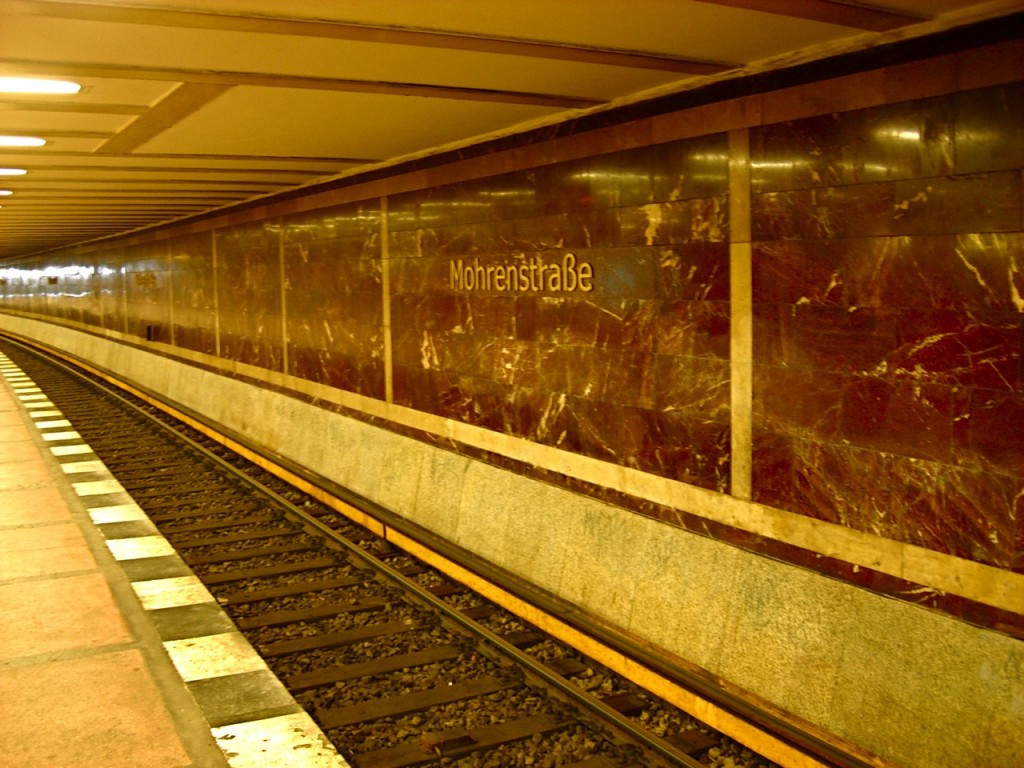Hitler’s Bloody Palace: Mohrenstraße
Blood red, sometimes purple, the marble’s colour was signed off by Hitler himself. It decked his grandest building, the New Reich Chancellery on Voßstraße, built by workers between 1938 and 1939. They slaved round-the-clock, and then, after the war, the Soviets demolished their effort at a breakneck pace. In few places has a project had such a megalomaniacal rise and fall (also in cost: in today’s coin, more than a billion euros). This only begins to suggest the delusions of the hubristic Nazi regime.
The crimson stone surrounded window frames, it paved the floors, it decked columns, and walls, tons and tons of it. Its lushness is enhanced by white fissures, invaders upsetting the unity. Heavy, and bloody, the hue makes one think of the precious carpet murderous Clytemnestra rolled out for Agamemnon, dyed with the purple juice of countless sea creatures.
Precious Saalburger marble, you can still buy it for your bathroom, it’s mined not far from here, in Thuringia. But you can’t imagine bathing in it, can you? Perhaps you are haunted, a little superstitious. You imagine filling the tub, and then the hot water running out red.
Where is it now?
The New Chancellery is gone, built over with pre-fabricated Soviet-era buildings. The victors left not a trace. The marble was trucked away (some say to build the Soviet Memorial in Treptow or to pave the entrance hall of the Humboldt University).
But it shows up in less likely places too.
When you wait for the metro at Mohrenstraße station on the U2 line, only a few steps from where the New Chancellery once stood, you might look up and admire the crimson stone. Step back and lean against a pillar, then realise it too was once part of Hitler’s palace. It may have been a slab he walked on himself.
With that thought, you jump back quickly from where you brushed against it. You examine your sleeves, to see if the colour has rubbed off. You are worried it will stain. But, to your astonishment, nothing is there.



The assumption that the marble came from Hitler’s chancellery has always been iff-y. Many argue that it is not the case and say there is no sufficient proof. They can only definitely say the marble originally came from Thuringia. You might want to check out this book too, before coming to any definite conclusions. Hans-Ernst Mittig: Marmor der Reichskanzlei In: Dieter Bingen, Hans-Martin Hinz (Hrsg.): Die Schleifung, Zerstörung und Wiederaufbau historischer Bauten in Deutschland und Polen. Wiesbaden 2005
Allie,
Thank you very much for your post! I am delighted to add my two cents to such a fascinating debate. I have now read Hans-Ernst Mittig’s article, and also the discussion it provoked when it was published.
While the argument that the Soviet Memorial in Treptow could not have been built from the marble of the Reich Chancellery has cogency (if it was built before the rubble of the New Reich Chancellery was cleared away), Mittig’s conclusions about the origin of the marble in Mohrenstraße U-Bahn are more easily subject to dispute.
He relies on two articles from 1950, in the newspapers Neues Deutschland and the Berliner Zeitung, which report that the marble was delivered to the U-Bahn station from Thuringia in August of that year (and so, by implication, could not have come from the Reich Chancellery). He writes: “Über die Herkunft des Steins berichteten am 19. August 1950 das Neue Deutschland und die Berliner Zeitung, die die Kürze der Bauzeit von 108 Tagen unterstrichen, es seien »die letzten Marmorplatten erst in der vergangenen Nacht aus Thuringen eingetroffen«’.
I would argue that his argument is not sufficiently foregrounded for two reasons. The first regards his sources. The news items he relies (exclusively) on were published in papers closely affiliated to Communist regime: Neues Deutschland was the newspaper of the Party (Sozialistischen Einheitspartei Deutschlands) and the Berliner Zeitung began under Soviet editorship and continued under state control. Neither newspaper could reasonably be expected to explain that the marble for an U-Bahn which was to be imminently dedicated to Ernst Thälmann (the leader of the German Communist Party for most of the Weimar period) was quarried from buildings of the regime responsible for his execution in Buchenwald in 1944. It is not surprising that they reported differently.
The second argument against Mittig’s thesis is that the grain and type of marble in the U-Bahn correspond exactly to that of the marble that was in Speer’s Marble Hall and the U-Bahn station was located in close proximity to the ruins of its source. (http://www.morgenpost.de/printarchiv/wwbm/article283136/Spuren_der_Steine.html ) Mittig’s only footnote to dispel this argument is the assertion that: ‘ Die räumliche Nähe liefert kein rationales Argument fur eine Herkunft des Materials aus der Reichskanzlei, denn es hätte in einer Werkstatt aufbereitet, also hin- und
her transportiert werden mussen’. The expense of moving marble from Thuringia is of course much greater than doing so within the immediate vicinity of the former New Reich Chancellery, and it is hard to see how the authorities could have justified the expense of importing such expensive stone (esp. in the post-War economic climate of the East) when it was available around the corner. I think, that with such physical (if you will archaeological evidence) working against his thesis, the burden of proof rests on Mittig to make a stronger case than he does. Until he does so, I will continue to believe that the claim (also made by the Senatsverwaltung für Stadtentwinklung) that the marble in the U-Bahn does indeed come from the ruins of Hitler’s offices is the more likely one.
Many thanks for raising a stimulating point!
Best wishes,
Joseph
Thank you -very much- for this insight!
Interesting stuff. I would point out that the argument was put forth by Hans-Ernst Mittig, rather than Dieter Bingen, who simply edited the work.
Also, I think your interpretation of the Morgenpost article is actually less sanguine than the article itself. They seem to be leaning towards that conclusion but are less certain than you. Do you have any sources for this “petrographic research” (as Wikipedia calls it)?
And surely one could make the argument that the Senatsverwaltung für Stadtentwinklung could have it’s reasons to be biased as well, no?
Thanks for your speedy reply! To me it still remains a mystery, but a fun one to mull over especially considering the immediate post-war climate. I have to say I don’t think the communists would balk at re-using something “Nazi” – there were so many things which they took over and simply renamed! By virtue of being communist, you could just wipe out the Nazi connection. But then I wonder when it was first suggested the marble came from the Reich Chancellery and what fueled people to want to believe this. All the stuff and discussions I like about BErlin!
@Robert: Many thanks for the correction. The author is course Mittig. I will make changes in my original post.
As for the sources indicating that the stone is the same as that which was found in the New Chancellery, I have a few: a couple are secondary (the Morgenpost, admittedly not the best source, and Brian Ladd’s Ghosts of Berlin (U Chicago, 1997). Ladd’s bibliography refers to Olaf Groehler’s Die neue Reichskanzlei, Das Ende (Berlin, 1995) which I would like to take a look at). Another source is primary testimony by Rochus Misch (last living occupant of Hitler’s Bunker) who describes how the stone from the Reichskanzlei (the floors of the Marble Hall) was re-used for the U-Bahn. I need to get my hands on a copy of his book, Der Letzte Zeuge (2008), which apparently includes this testimony. But until I do, I won’t be quite satisfied. (If anyone has further sources, please do post them here!)
That said, I also do not think Mittig’s evidence from the censored newspapers is very convincing, and so I am willing to stick out my neck a little more than the Morgenpost of today (which doesn’t consider his sources), given the proximity of the station to a big stockpile of marble that was remarkably similar at the time! And while popular explanations for buildings in the city can turn out to be very wrong, until a well-documented alternative is provided, then the basis for questioning the assumed origin of the marble is still thin.
@Allie: I completely agree the Communists wouldn’t have balked at using Nazi materials for their buildings. But I do think they would not have admitted it but, as you say, wipe out the Nazi connection instead. Thanks for initiating such an interesting discussion!
Many thanks!
Joseph